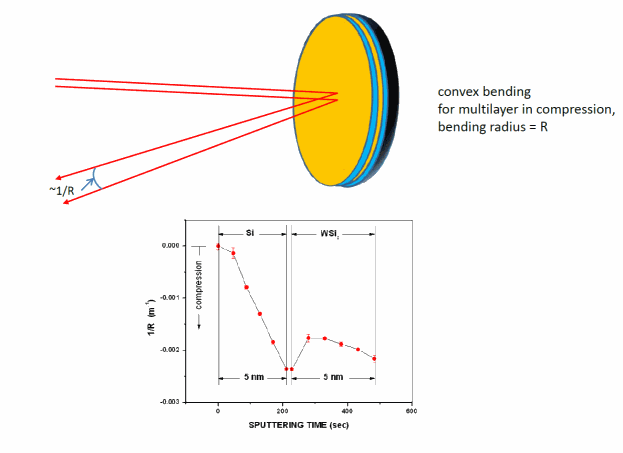Multilayer Laue lenses (MLLs) developed at the U.S. Department of Energy Office of Science’s Advanced Photon Source (APS) focus high-energy x-rays so tightly they can detect objects as small as 16 nanometers in size, and are in principle capable of focusing well below 10 nanometers. As recently reported on the Argonne National Laboratory homepage (http://www.anl.gov/Media_Center/News/2011/news110815_Laue.html) this approach doubles the resolution over existing lenses, and future advancements could increase resolution by 10 times. Furthermore, large-diameter MLLs have the potential to achieve a very high efficiency, enabling detailed studies of individual nanoparticles. Now, studies carried out by researchers at the APS reveal a simple means to reduce stress in MLLs, thereby removing a possible obstacle to maximizing the potential of these lenses.
Future MLLs with an overall growth thicknesses in excess of 50 µm will be needed to focus the full brilliance of APS x-ray beams to spot sizes of 5 nm and below. Any built-up stress, if not reduced, can limit the maximum useful thickness of the MLL. Excessive stress can cause delamination of the lenses during processing of deposited multilayers into ready-to-use lenses. However, as recently reported in Applied Physics Letters, there is a way to reduce the grown-in stress.
Since their invention at the APS, MLLs and the technology needed to make them have progressed to the point where a focus spot of 25 nm x 27 nm was recently reported in Optics Express [1]. The deposited thicknesses for the two crossed lenses were 12.4 µm and 13.4 µm, which limited the focused flux to approximately 1% of what could ideally be obtained. Future lenses will require thicker deposits, and methods to reduce stress are needed.
Grown-in stress resulting from a newly deposited layer can be measured by monitoring the change in the radius-of-curvature of the entire wafer, as schematically shown in the top part of the accompanying figure. The formula that relates the stress to this curvature was first published by G.G. Stoney in 1909, and measurements of curvature offer a very simple and powerful means to monitor changes after only 1 nanometer of a thin film is deposited on a substrate via sputter deposition, as shown in the bottom part of the figure. The fact that stress in very thin layers can be studied is reported in Applied Physics Letters [2]. The data reveal that more of the grown-in stress arises from the Si layers than from the WSi2 layers, so that a reduction in the fraction of the multilayer period that is Si should be effective.
This simple means to reduce stress is presently an active area of research at the APS, and the preliminary results point to an effective path towards larger diameter optics.
— Al Macrander
References
[1] Hanfei Yan, Volker Rose, Deming Shu, Enju Lima, Hyon Chol Kang, Ray Conley, Chian Liu, Nima Jahedi, Albert T. Macrander, G. Brian Stephenson, Martin Holt, Yong S. Chu, Ming Lu, and Jorg Maser, “Two dimensional hard x-ray nanofocusing with crossed multilayer Laue lenses,” Opt. Express 19, 15069 (2011).
[2] Kimberly MacArthur, Bing Shi, Ray Conley, and Albert T. Macrander, “Periodic variation of stress in sputter deposited Si/WSi2 multilayers,” Appl. Phys. Lett. 99, 081905 (2011).
Corresponding author: [email protected]
The Advanced Photon Source at Argonne National Laboratory is one of five national synchrotron radiation light sources supported by the U.S. Department of Energy’s Office of Science to carry out applied and basic research to understand, predict, and ultimately control matter and energy at the electronic, atomic, and molecular levels, provide the foundations for new energy technologies, and support DOE missions in energy, environment, and national security. To learn more about the Office of Science x-ray user facilities, visit http://science.energy.gov/user-facilities/basic-energy-sciences/.
Argonne National Laboratory seeks solutions to pressing national problems in science and technology. The nation's first national laboratory, Argonne conducts leading-edge basic and applied scientific research in virtually every scientific discipline. Argonne researchers work closely with researchers from hundreds of companies, universities, and federal, state and municipal agencies to help them solve their specific problems, advance America's scientific leadership and prepare the nation for a better future. With employees from more than 60 nations, Argonne is managed by UChicago Argonne, LLC for the U.S. Department of Energy's Office of Science.

